Financial Management Concepts: Analysis, Application, and Evaluation
VerifiedAdded on 2020/05/16
|12
|1852
|77
Homework Assignment
AI Summary
This assignment delves into crucial financial management concepts. It begins with an analysis of tax slabs and their implications, followed by calculations of investment returns and standard deviations for common stocks, exploring risk and return trade-offs. The assignment continues with discussions on funding requirements, financial ratio analysis (current ratio, inventory turnover, etc.), and the time value of money. It also covers topics like economic order quantity, foreign exchange risk management, and key financial principles such as "cash is king" and incremental cash flows. Furthermore, it provides an overview of concepts like the agency problem, tax bias, and ethical dilemmas in business, offering a comprehensive understanding of financial management principles.
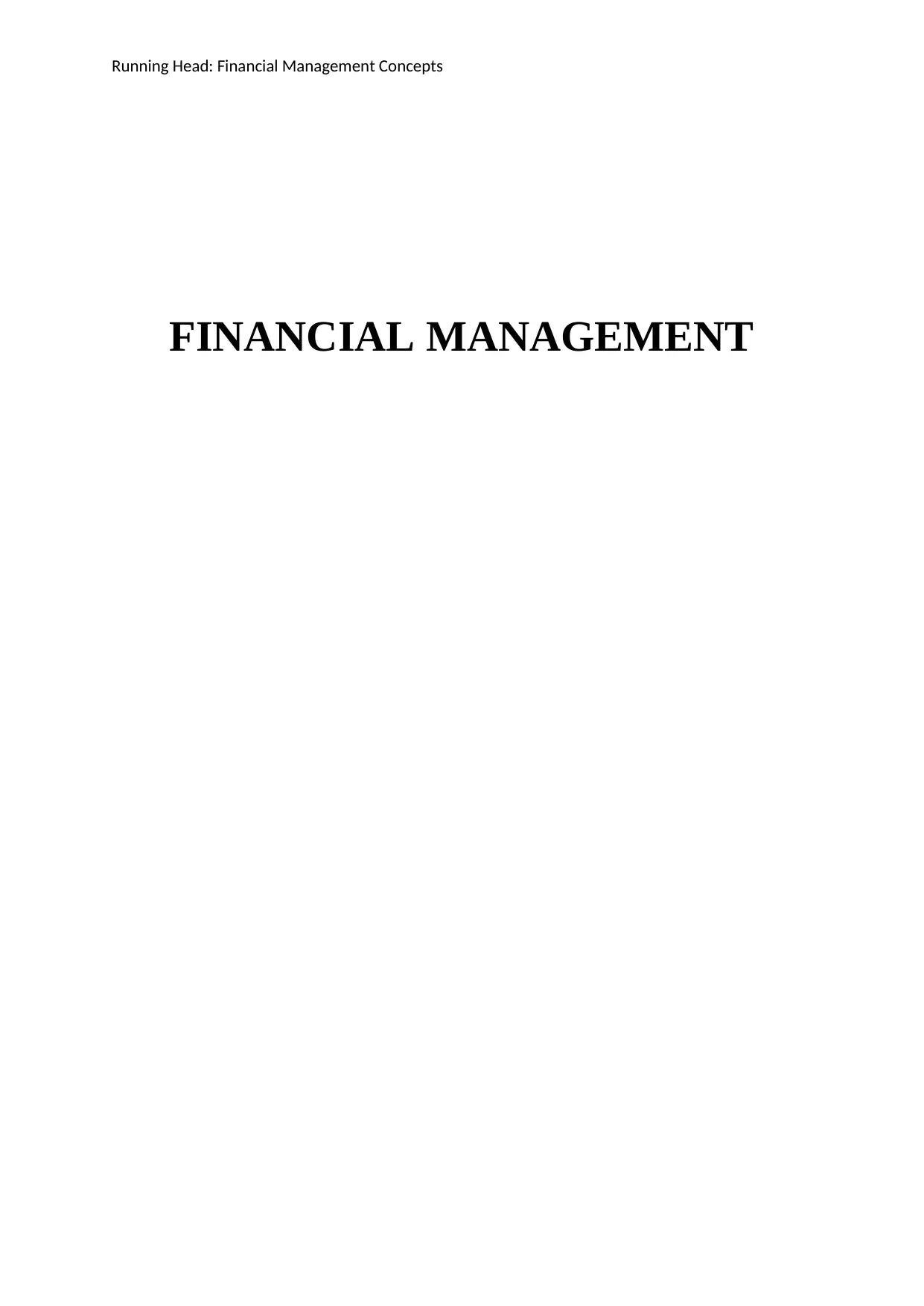
Running Head: Financial Management Concepts
FINANCIAL MANAGEMENT
FINANCIAL MANAGEMENT
Paraphrase This Document
Need a fresh take? Get an instant paraphrase of this document with our AI Paraphraser

Financial Management Concepts 1
Question 1
Part a)
Tax slabs Tax rate Tax
0-$50000 $ 50,000.00 15 % $ 7,500.00
$50001-$75000 $ 25,000.00 25 % $ 6,250.00
$75001-$10000000 $ 11,50,000.00 34 % $ 3,91,000.00
Total tax $ 4,04,750.00
Part b)
Though the main objective of taxation of incomes of individuals and business units is to
collect the revenue for meeting the capital expenditures. Major portion of governmental
activities are financed from the revenue generated by taxing the incomes. But taxation of
income has certain non-revenue related objectives such as economic development. In the
modern world, taxation is considered as the most important instrument of the economic
policies of the country (Arnold, 2008). Economic development of company is supported by the
growth in the capital formation of such country. To prevent the problems of scarcity of
capital resources, government mobilise such resources to facilitate rapid accumulation of
capital. Through appropriate tax planning, the savings to national income ratio can be
improved.
The taxation of income has also some social objectives such as reduction of inequalities. A
country intending to promote the equality of income must use taxation tool as it can
effectively reduce the inequalities of wealth of the community (Lee & Gordon, 2005).
Question 2
Question 1
Part a)
Tax slabs Tax rate Tax
0-$50000 $ 50,000.00 15 % $ 7,500.00
$50001-$75000 $ 25,000.00 25 % $ 6,250.00
$75001-$10000000 $ 11,50,000.00 34 % $ 3,91,000.00
Total tax $ 4,04,750.00
Part b)
Though the main objective of taxation of incomes of individuals and business units is to
collect the revenue for meeting the capital expenditures. Major portion of governmental
activities are financed from the revenue generated by taxing the incomes. But taxation of
income has certain non-revenue related objectives such as economic development. In the
modern world, taxation is considered as the most important instrument of the economic
policies of the country (Arnold, 2008). Economic development of company is supported by the
growth in the capital formation of such country. To prevent the problems of scarcity of
capital resources, government mobilise such resources to facilitate rapid accumulation of
capital. Through appropriate tax planning, the savings to national income ratio can be
improved.
The taxation of income has also some social objectives such as reduction of inequalities. A
country intending to promote the equality of income must use taxation tool as it can
effectively reduce the inequalities of wealth of the community (Lee & Gordon, 2005).
Question 2

Financial Management Concepts 2
Part a)
Return from both the common stocks
Return = R1WI + R2W2 + R3W3
(0.20*12)+(0.50*18)+(0.30*27)
A 19.5%
B R1WI + R2W2 + R3W3 + R4W4
(0.10*4)+
(0.30*6)+(0.40*10)+(0.20*15)
9.2%
Standard deviation from the common stocks
Common Stock A
Probability
Return
(%)
Deviation
Deviation
square
Deviation
square x P
0.2 0.12 -19.38 375.58 75.12
0.5 0.18 -19.32 373.26 186.63
0.3 0.27 -19.23 369.79 110.94
Variance 372.69
Standard Deviation 19.31%
Common Stock B
Probability Return Deviation Deviation square
0.1 0.04 -9.16 83.9056 8.39056
Part a)
Return from both the common stocks
Return = R1WI + R2W2 + R3W3
(0.20*12)+(0.50*18)+(0.30*27)
A 19.5%
B R1WI + R2W2 + R3W3 + R4W4
(0.10*4)+
(0.30*6)+(0.40*10)+(0.20*15)
9.2%
Standard deviation from the common stocks
Common Stock A
Probability
Return
(%)
Deviation
Deviation
square
Deviation
square x P
0.2 0.12 -19.38 375.58 75.12
0.5 0.18 -19.32 373.26 186.63
0.3 0.27 -19.23 369.79 110.94
Variance 372.69
Standard Deviation 19.31%
Common Stock B
Probability Return Deviation Deviation square
0.1 0.04 -9.16 83.9056 8.39056
⊘ This is a preview!⊘
Do you want full access?
Subscribe today to unlock all pages.

Trusted by 1+ million students worldwide

Financial Management Concepts 3
0.3 0.06 -9.14 83.5396 25.06188
0.4 0.10 -9.1 82.81 33.124
0.2 0.15 -9.05 81.9025 16.3805
Variance 66.58
Standard
Deviation 8.16
From the point of view of return the common stock A will be chosen as it has higher return
potential and from the view point of standard deviation common stock B will be selected as it
will have lower risk (Higgins, 2012).
Part b)
All investments involve some or the other financial risk due to the uncertainty factor attached
with the returns intended to be generated from the investment. As the risk of any investment
rises, the investors expects higher return on such investments.
Diversification of investment is the most effective method of minimising the risks of the
investments and maximising the returns out of such investments. Diversification involves
allocating the surplus funds to the different areas of investments such as financial
instruments, industries etc. (Heaton, 2002). Different investments does not react to the market
and business conditions in the same way and at the same time. Therefore, the combination of
various investment assets reduces the sensitivity of ones portfolio to the typical market
swings.
0.3 0.06 -9.14 83.5396 25.06188
0.4 0.10 -9.1 82.81 33.124
0.2 0.15 -9.05 81.9025 16.3805
Variance 66.58
Standard
Deviation 8.16
From the point of view of return the common stock A will be chosen as it has higher return
potential and from the view point of standard deviation common stock B will be selected as it
will have lower risk (Higgins, 2012).
Part b)
All investments involve some or the other financial risk due to the uncertainty factor attached
with the returns intended to be generated from the investment. As the risk of any investment
rises, the investors expects higher return on such investments.
Diversification of investment is the most effective method of minimising the risks of the
investments and maximising the returns out of such investments. Diversification involves
allocating the surplus funds to the different areas of investments such as financial
instruments, industries etc. (Heaton, 2002). Different investments does not react to the market
and business conditions in the same way and at the same time. Therefore, the combination of
various investment assets reduces the sensitivity of ones portfolio to the typical market
swings.
Paraphrase This Document
Need a fresh take? Get an instant paraphrase of this document with our AI Paraphraser
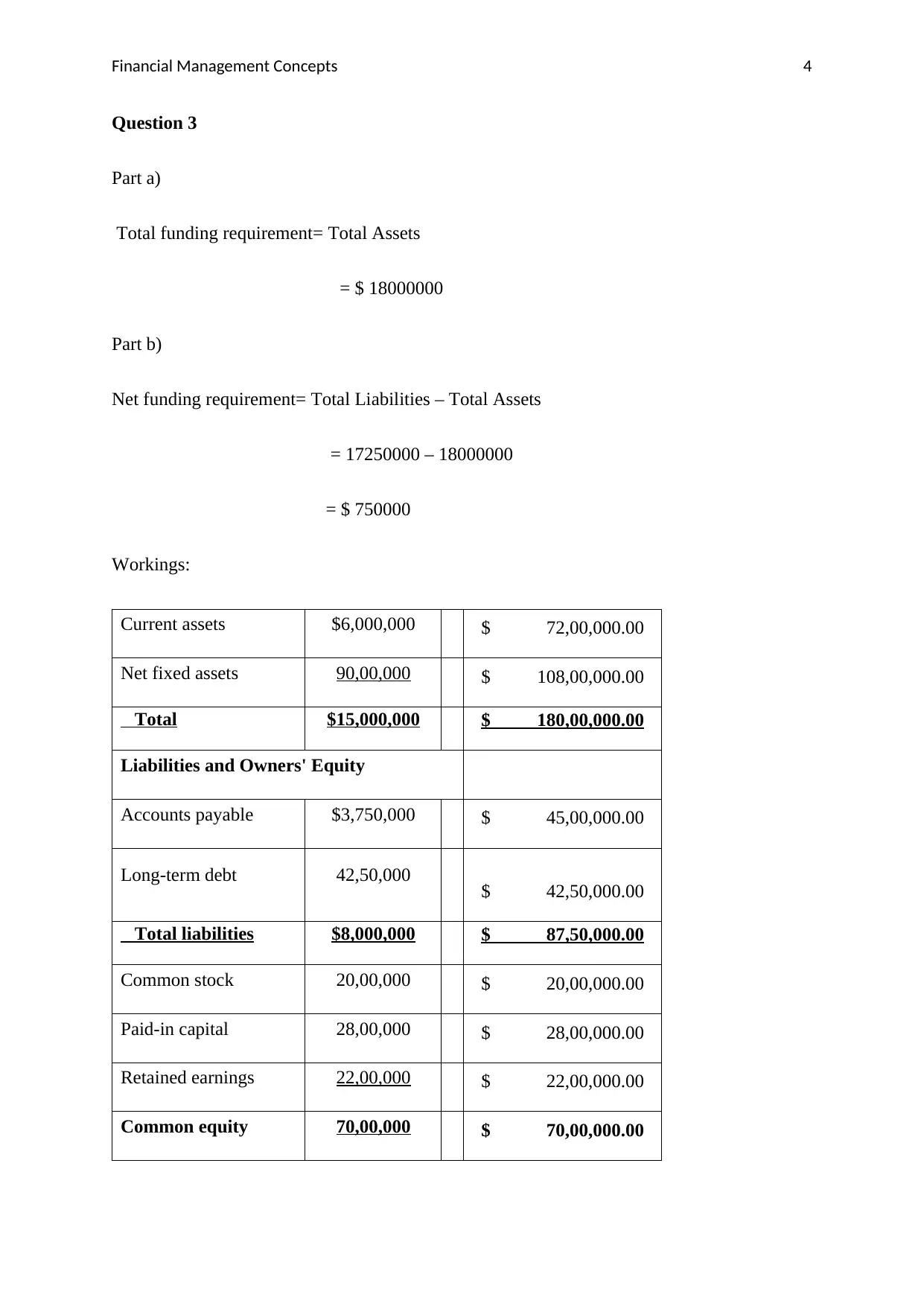
Financial Management Concepts 4
Question 3
Part a)
Total funding requirement= Total Assets
= $ 18000000
Part b)
Net funding requirement= Total Liabilities – Total Assets
= 17250000 – 18000000
= $ 750000
Workings:
Current assets $6,000,000 $ 72,00,000.00
Net fixed assets 90,00,000 $ 108,00,000.00
Total $15,000,000 $ 180,00,000.00
Liabilities and Owners' Equity
Accounts payable $3,750,000 $ 45,00,000.00
Long-term debt 42,50,000 $ 42,50,000.00
Total liabilities $8,000,000 $ 87,50,000.00
Common stock 20,00,000 $ 20,00,000.00
Paid-in capital 28,00,000 $ 28,00,000.00
Retained earnings 22,00,000 $ 22,00,000.00
Common equity 70,00,000 $ 70,00,000.00
Question 3
Part a)
Total funding requirement= Total Assets
= $ 18000000
Part b)
Net funding requirement= Total Liabilities – Total Assets
= 17250000 – 18000000
= $ 750000
Workings:
Current assets $6,000,000 $ 72,00,000.00
Net fixed assets 90,00,000 $ 108,00,000.00
Total $15,000,000 $ 180,00,000.00
Liabilities and Owners' Equity
Accounts payable $3,750,000 $ 45,00,000.00
Long-term debt 42,50,000 $ 42,50,000.00
Total liabilities $8,000,000 $ 87,50,000.00
Common stock 20,00,000 $ 20,00,000.00
Paid-in capital 28,00,000 $ 28,00,000.00
Retained earnings 22,00,000 $ 22,00,000.00
Common equity 70,00,000 $ 70,00,000.00
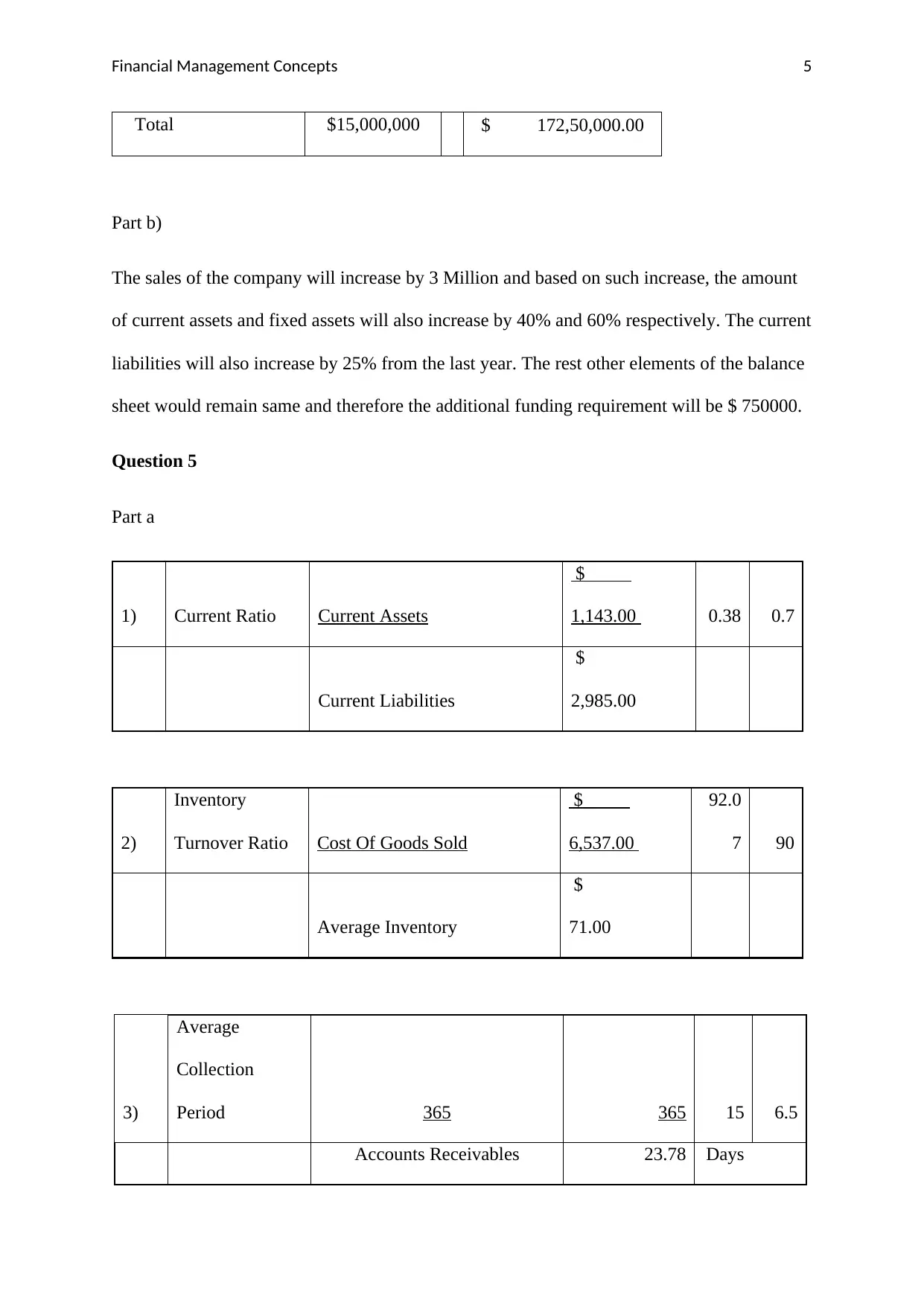
Financial Management Concepts 5
Total $15,000,000 $ 172,50,000.00
Part b)
The sales of the company will increase by 3 Million and based on such increase, the amount
of current assets and fixed assets will also increase by 40% and 60% respectively. The current
liabilities will also increase by 25% from the last year. The rest other elements of the balance
sheet would remain same and therefore the additional funding requirement will be $ 750000.
Question 5
Part a
1) Current Ratio Current Assets
$
1,143.00 0.38 0.7
Current Liabilities
$
2,985.00
2)
Inventory
Turnover Ratio Cost Of Goods Sold
$
6,537.00
92.0
7 90
Average Inventory
$
71.00
3)
Average
Collection
Period 365 365 15 6.5
Accounts Receivables 23.78 Days
Total $15,000,000 $ 172,50,000.00
Part b)
The sales of the company will increase by 3 Million and based on such increase, the amount
of current assets and fixed assets will also increase by 40% and 60% respectively. The current
liabilities will also increase by 25% from the last year. The rest other elements of the balance
sheet would remain same and therefore the additional funding requirement will be $ 750000.
Question 5
Part a
1) Current Ratio Current Assets
$
1,143.00 0.38 0.7
Current Liabilities
$
2,985.00
2)
Inventory
Turnover Ratio Cost Of Goods Sold
$
6,537.00
92.0
7 90
Average Inventory
$
71.00
3)
Average
Collection
Period 365 365 15 6.5
Accounts Receivables 23.78 Days
⊘ This is a preview!⊘
Do you want full access?
Subscribe today to unlock all pages.

Trusted by 1+ million students worldwide
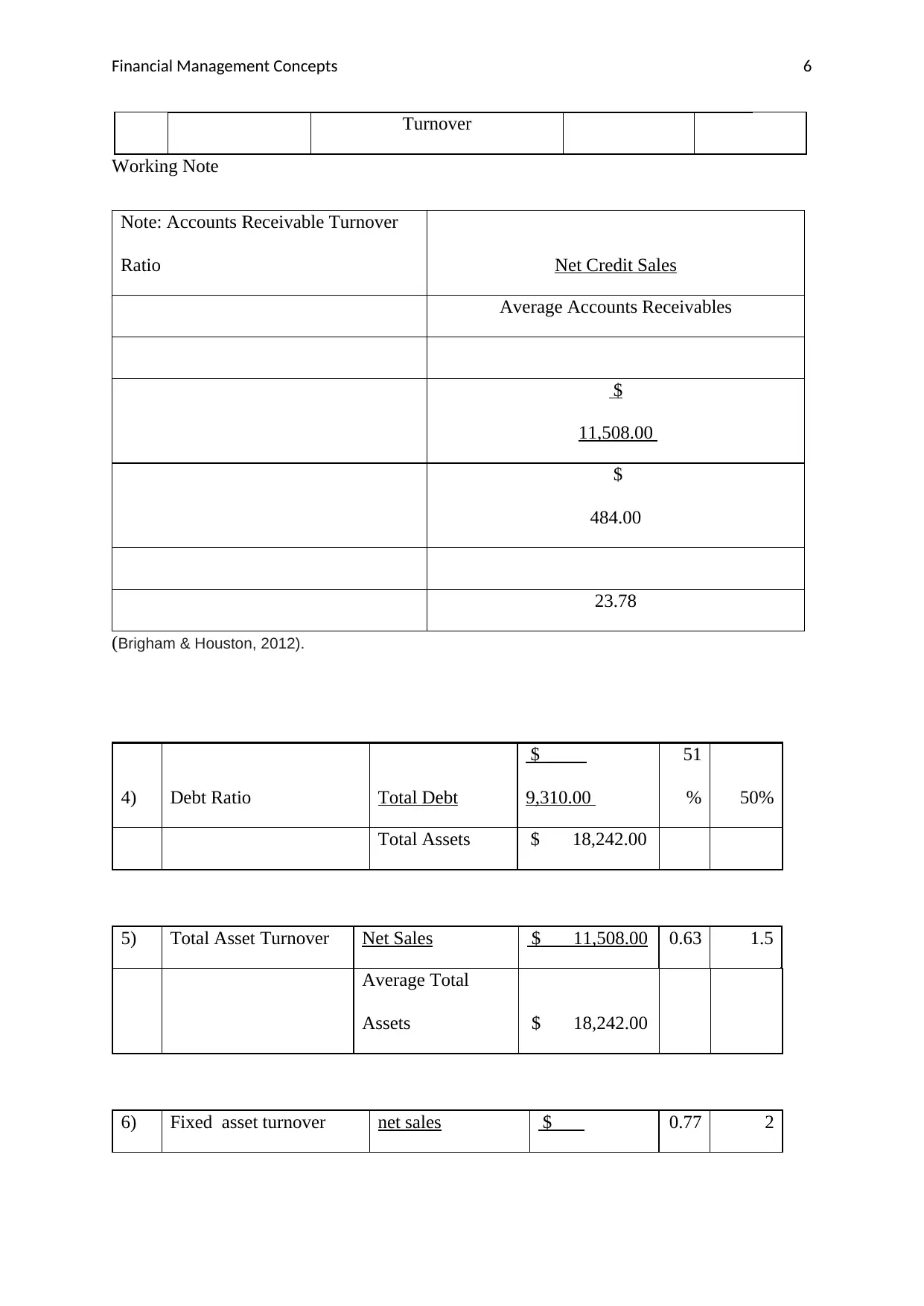
Financial Management Concepts 6
Turnover
Working Note
Note: Accounts Receivable Turnover
Ratio Net Credit Sales
Average Accounts Receivables
$
11,508.00
$
484.00
23.78
(Brigham & Houston, 2012).
4) Debt Ratio Total Debt
$
9,310.00
51
% 50%
Total Assets $ 18,242.00
5) Total Asset Turnover Net Sales $ 11,508.00 0.63 1.5
Average Total
Assets $ 18,242.00
6) Fixed asset turnover net sales $ 0.77 2
Turnover
Working Note
Note: Accounts Receivable Turnover
Ratio Net Credit Sales
Average Accounts Receivables
$
11,508.00
$
484.00
23.78
(Brigham & Houston, 2012).
4) Debt Ratio Total Debt
$
9,310.00
51
% 50%
Total Assets $ 18,242.00
5) Total Asset Turnover Net Sales $ 11,508.00 0.63 1.5
Average Total
Assets $ 18,242.00
6) Fixed asset turnover net sales $ 0.77 2
Paraphrase This Document
Need a fresh take? Get an instant paraphrase of this document with our AI Paraphraser

Financial Management Concepts 7
11,508.00
average fixed
assets
$
14,961.00
7) Operating Profit Margin Operating Income
$
2,794.00
24.28
% 21%
Net Sales
$
11,508.00
8)
return on Common
Equity
net income after
preference
dividends
$
1,617.00
18.27
%
15
%
average common
stock holder's
equity
$
8,852.00
Part b)
Year Opening Balance Interest Closing Balance
1 $ 5,000.00 $ 300.00 $ 5,300.00
2 $ 5,300.00 $ 318.00 $ 5,618.00
3 $ 5,618.00 $ 337.08 $ 5,955.08
4 $ 5,955.08 $ 357.30 $ 6,312.38
5 $ 6,312.38 $ 378.74 $ 6,691.13
11,508.00
average fixed
assets
$
14,961.00
7) Operating Profit Margin Operating Income
$
2,794.00
24.28
% 21%
Net Sales
$
11,508.00
8)
return on Common
Equity
net income after
preference
dividends
$
1,617.00
18.27
%
15
%
average common
stock holder's
equity
$
8,852.00
Part b)
Year Opening Balance Interest Closing Balance
1 $ 5,000.00 $ 300.00 $ 5,300.00
2 $ 5,300.00 $ 318.00 $ 5,618.00
3 $ 5,618.00 $ 337.08 $ 5,955.08
4 $ 5,955.08 $ 357.30 $ 6,312.38
5 $ 6,312.38 $ 378.74 $ 6,691.13
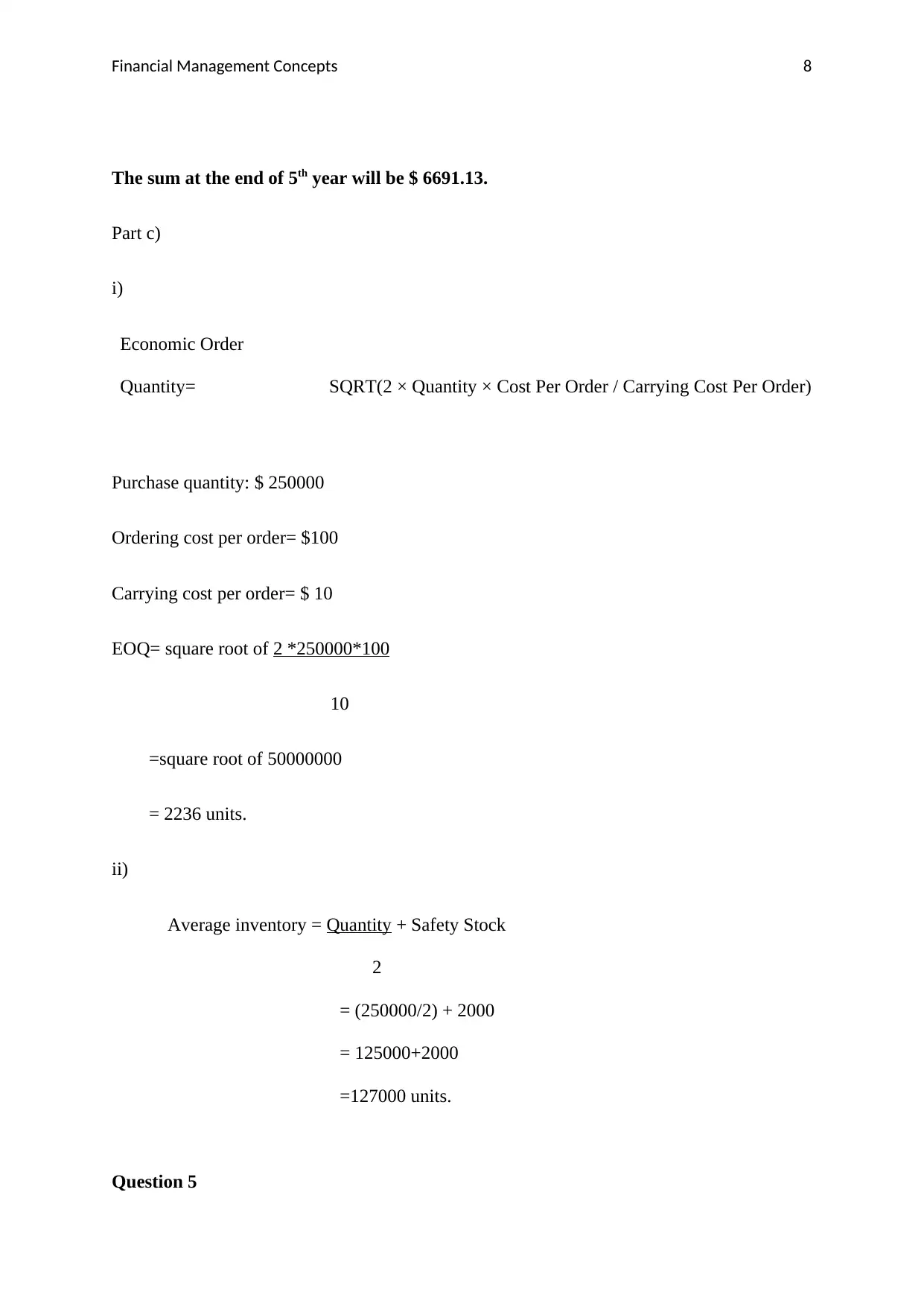
Financial Management Concepts 8
The sum at the end of 5th year will be $ 6691.13.
Part c)
i)
Economic Order
Quantity= SQRT(2 × Quantity × Cost Per Order / Carrying Cost Per Order)
Purchase quantity: $ 250000
Ordering cost per order= $100
Carrying cost per order= $ 10
EOQ= square root of 2 *250000*100
10
=square root of 50000000
= 2236 units.
ii)
Average inventory = Quantity + Safety Stock
2
= (250000/2) + 2000
= 125000+2000
=127000 units.
Question 5
The sum at the end of 5th year will be $ 6691.13.
Part c)
i)
Economic Order
Quantity= SQRT(2 × Quantity × Cost Per Order / Carrying Cost Per Order)
Purchase quantity: $ 250000
Ordering cost per order= $100
Carrying cost per order= $ 10
EOQ= square root of 2 *250000*100
10
=square root of 50000000
= 2236 units.
ii)
Average inventory = Quantity + Safety Stock
2
= (250000/2) + 2000
= 125000+2000
=127000 units.
Question 5
⊘ This is a preview!⊘
Do you want full access?
Subscribe today to unlock all pages.

Trusted by 1+ million students worldwide
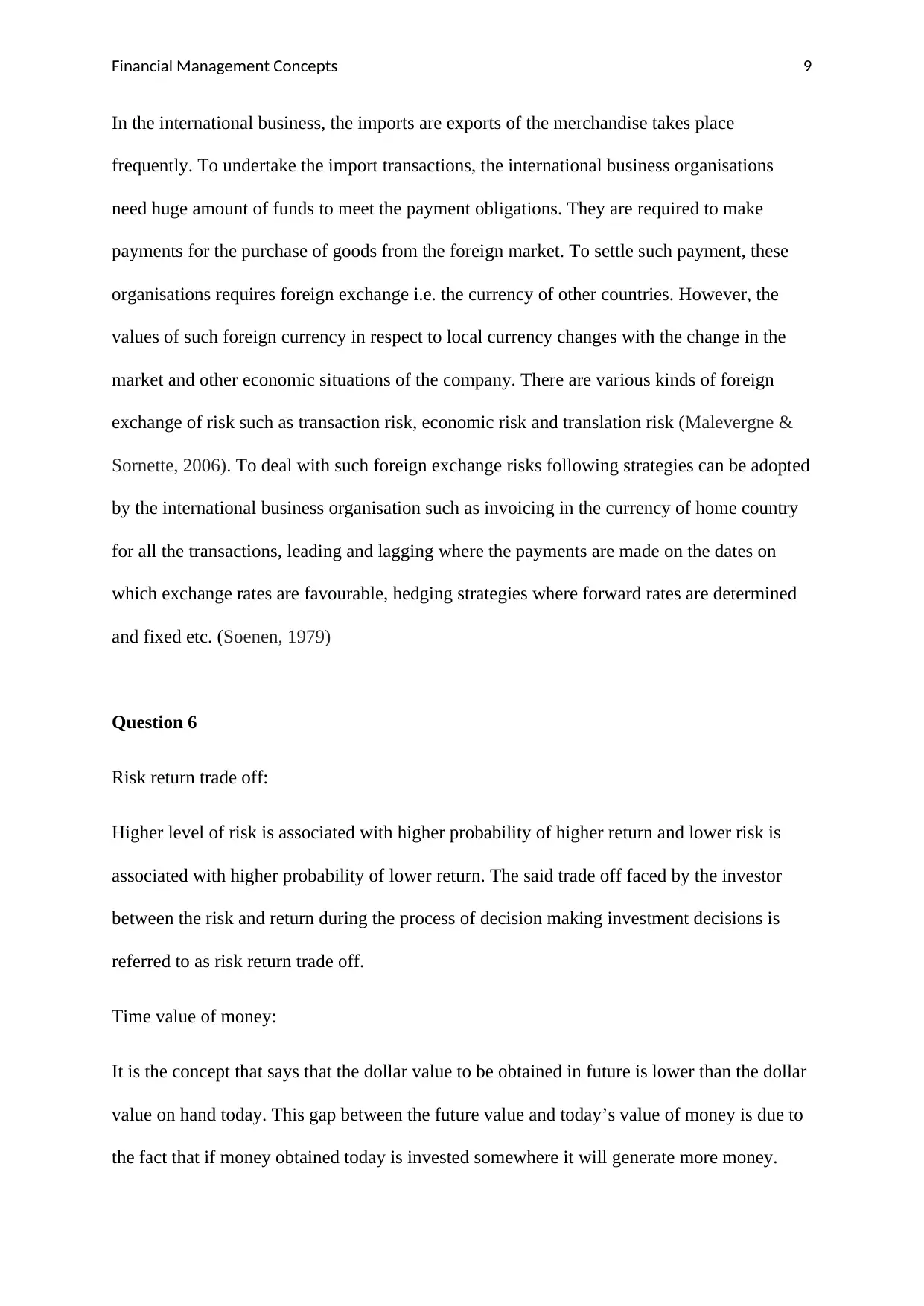
Financial Management Concepts 9
In the international business, the imports are exports of the merchandise takes place
frequently. To undertake the import transactions, the international business organisations
need huge amount of funds to meet the payment obligations. They are required to make
payments for the purchase of goods from the foreign market. To settle such payment, these
organisations requires foreign exchange i.e. the currency of other countries. However, the
values of such foreign currency in respect to local currency changes with the change in the
market and other economic situations of the company. There are various kinds of foreign
exchange of risk such as transaction risk, economic risk and translation risk (Malevergne &
Sornette, 2006). To deal with such foreign exchange risks following strategies can be adopted
by the international business organisation such as invoicing in the currency of home country
for all the transactions, leading and lagging where the payments are made on the dates on
which exchange rates are favourable, hedging strategies where forward rates are determined
and fixed etc. (Soenen, 1979)
Question 6
Risk return trade off:
Higher level of risk is associated with higher probability of higher return and lower risk is
associated with higher probability of lower return. The said trade off faced by the investor
between the risk and return during the process of decision making investment decisions is
referred to as risk return trade off.
Time value of money:
It is the concept that says that the dollar value to be obtained in future is lower than the dollar
value on hand today. This gap between the future value and today’s value of money is due to
the fact that if money obtained today is invested somewhere it will generate more money.
In the international business, the imports are exports of the merchandise takes place
frequently. To undertake the import transactions, the international business organisations
need huge amount of funds to meet the payment obligations. They are required to make
payments for the purchase of goods from the foreign market. To settle such payment, these
organisations requires foreign exchange i.e. the currency of other countries. However, the
values of such foreign currency in respect to local currency changes with the change in the
market and other economic situations of the company. There are various kinds of foreign
exchange of risk such as transaction risk, economic risk and translation risk (Malevergne &
Sornette, 2006). To deal with such foreign exchange risks following strategies can be adopted
by the international business organisation such as invoicing in the currency of home country
for all the transactions, leading and lagging where the payments are made on the dates on
which exchange rates are favourable, hedging strategies where forward rates are determined
and fixed etc. (Soenen, 1979)
Question 6
Risk return trade off:
Higher level of risk is associated with higher probability of higher return and lower risk is
associated with higher probability of lower return. The said trade off faced by the investor
between the risk and return during the process of decision making investment decisions is
referred to as risk return trade off.
Time value of money:
It is the concept that says that the dollar value to be obtained in future is lower than the dollar
value on hand today. This gap between the future value and today’s value of money is due to
the fact that if money obtained today is invested somewhere it will generate more money.
Paraphrase This Document
Need a fresh take? Get an instant paraphrase of this document with our AI Paraphraser
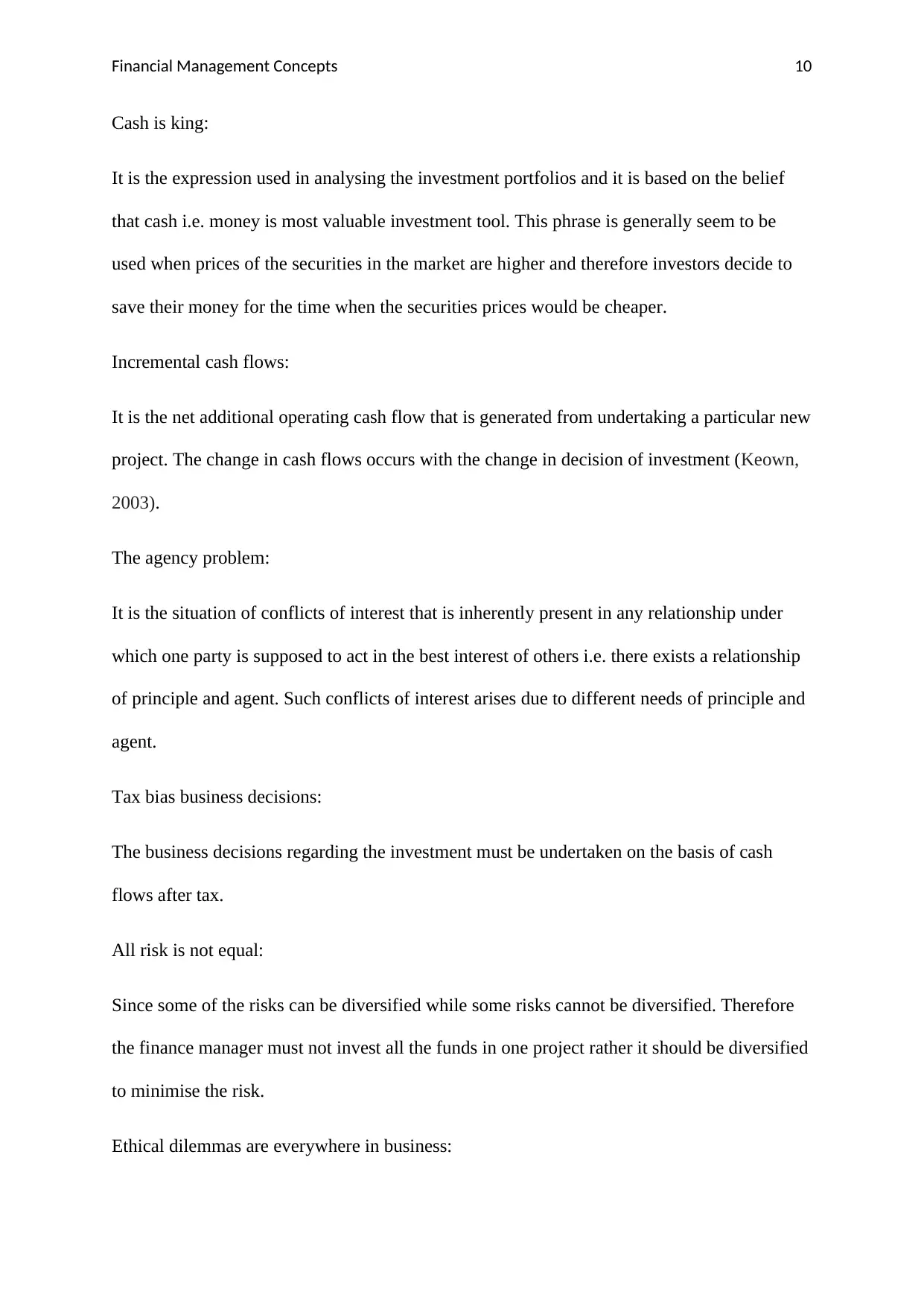
Financial Management Concepts 10
Cash is king:
It is the expression used in analysing the investment portfolios and it is based on the belief
that cash i.e. money is most valuable investment tool. This phrase is generally seem to be
used when prices of the securities in the market are higher and therefore investors decide to
save their money for the time when the securities prices would be cheaper.
Incremental cash flows:
It is the net additional operating cash flow that is generated from undertaking a particular new
project. The change in cash flows occurs with the change in decision of investment (Keown,
2003).
The agency problem:
It is the situation of conflicts of interest that is inherently present in any relationship under
which one party is supposed to act in the best interest of others i.e. there exists a relationship
of principle and agent. Such conflicts of interest arises due to different needs of principle and
agent.
Tax bias business decisions:
The business decisions regarding the investment must be undertaken on the basis of cash
flows after tax.
All risk is not equal:
Since some of the risks can be diversified while some risks cannot be diversified. Therefore
the finance manager must not invest all the funds in one project rather it should be diversified
to minimise the risk.
Ethical dilemmas are everywhere in business:
Cash is king:
It is the expression used in analysing the investment portfolios and it is based on the belief
that cash i.e. money is most valuable investment tool. This phrase is generally seem to be
used when prices of the securities in the market are higher and therefore investors decide to
save their money for the time when the securities prices would be cheaper.
Incremental cash flows:
It is the net additional operating cash flow that is generated from undertaking a particular new
project. The change in cash flows occurs with the change in decision of investment (Keown,
2003).
The agency problem:
It is the situation of conflicts of interest that is inherently present in any relationship under
which one party is supposed to act in the best interest of others i.e. there exists a relationship
of principle and agent. Such conflicts of interest arises due to different needs of principle and
agent.
Tax bias business decisions:
The business decisions regarding the investment must be undertaken on the basis of cash
flows after tax.
All risk is not equal:
Since some of the risks can be diversified while some risks cannot be diversified. Therefore
the finance manager must not invest all the funds in one project rather it should be diversified
to minimise the risk.
Ethical dilemmas are everywhere in business:

Financial Management Concepts 11
While making any financial decision a finance manager has to face a dilemma in choosing
the right financial decision from among all the possible actions to be undertaken from among
all the possible actions that can be undertaken.
The curse of competitive markets:
It is always hard to identify and maintain projects that are exceptionally profitable and every
profitable project attracts a large number of competitors. So if any managers wants their
project to be profitable they will have to face intense competition from market.
Efficient capital markets:
These are the markets where all the information in relation to securities values are
incorporated in its prices with accuracy and in real time.
While making any financial decision a finance manager has to face a dilemma in choosing
the right financial decision from among all the possible actions to be undertaken from among
all the possible actions that can be undertaken.
The curse of competitive markets:
It is always hard to identify and maintain projects that are exceptionally profitable and every
profitable project attracts a large number of competitors. So if any managers wants their
project to be profitable they will have to face intense competition from market.
Efficient capital markets:
These are the markets where all the information in relation to securities values are
incorporated in its prices with accuracy and in real time.
⊘ This is a preview!⊘
Do you want full access?
Subscribe today to unlock all pages.

Trusted by 1+ million students worldwide
1 out of 12
Related Documents
Your All-in-One AI-Powered Toolkit for Academic Success.
+13062052269
info@desklib.com
Available 24*7 on WhatsApp / Email
![[object Object]](/_next/static/media/star-bottom.7253800d.svg)
Unlock your academic potential
Copyright © 2020–2025 A2Z Services. All Rights Reserved. Developed and managed by ZUCOL.





